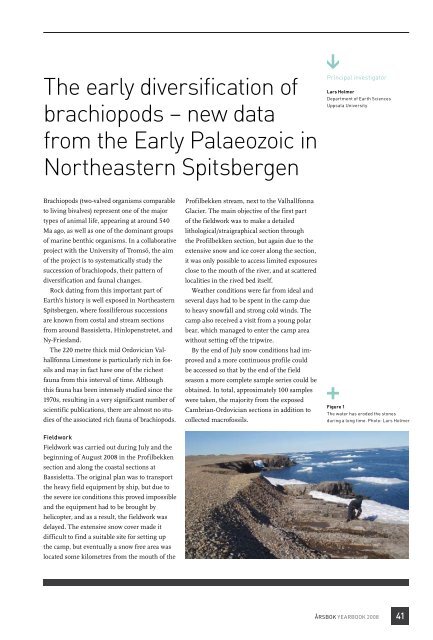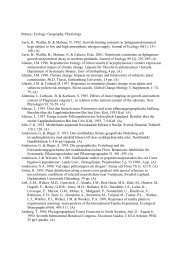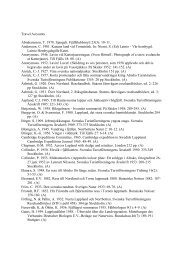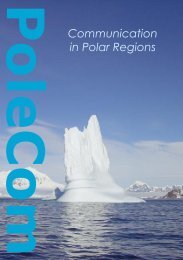Ladda ner årsbok 2008 (6,5 MB) - Polarforskningssekretariatet
Ladda ner årsbok 2008 (6,5 MB) - Polarforskningssekretariatet
Ladda ner årsbok 2008 (6,5 MB) - Polarforskningssekretariatet
You also want an ePaper? Increase the reach of your titles
YUMPU automatically turns print PDFs into web optimized ePapers that Google loves.
the early diversification of<br />
brachiopods – new data<br />
from the early Palaeozoic in<br />
Northeastern spitsbergen<br />
Brachiopods (two-valved organisms comparable<br />
to living bivalves) represent one of the major<br />
types of animal life, appearing at around 540<br />
Ma ago, as well as one of the dominant groups<br />
of marine benthic organisms. In a collaborative<br />
project with the University of Tromsö, the aim<br />
of the project is to systematically study the<br />
succession of brachiopods, their pattern of<br />
diversification and faunal changes.<br />
Rock dating from this important part of<br />
Earth’s history is well exposed in Northeastern<br />
Spitsbergen, where fossiliferous successions<br />
are known from costal and stream sections<br />
from around Bassisletta, Hinlopenstretet, and<br />
Ny-Friesland.<br />
The 220 metre thick mid Ordovician Valhallfonna<br />
Limestone is particularly rich in fossils<br />
and may in fact have one of the richest<br />
fauna from this interval of time. Although<br />
this fauna has been intensely studied since the<br />
1970s, resulting in a very significant number of<br />
scientific publications, there are almost no studies<br />
of the associated rich fauna of brachiopods.<br />
Fieldwork<br />
Fieldwork was carried out during July and the<br />
beginning of August <strong>2008</strong> in the Profilbekken<br />
section and along the coastal sections at<br />
Bassisletta. The original plan was to transport<br />
the heavy field equipment by ship, but due to<br />
the severe ice conditions this proved impossible<br />
and the equipment had to be brought by<br />
helicopter, and as a result, the fieldwork was<br />
delayed. The extensive snow cover made it<br />
difficult to find a suitable site for setting up<br />
the camp, but eventually a snow free area was<br />
located some kilometres from the mouth of the<br />
Profilbekken stream, next to the Valhallfonna<br />
Glacier. The main objective of the first part<br />
of the fieldwork was to make a detailed<br />
lithological/straigraphical section through<br />
the Profilbekken section, but again due to the<br />
extensive snow and ice cover along the section,<br />
it was only possible to access limited exposures<br />
close to the mouth of the river, and at scattered<br />
localities in the rived bed itself.<br />
Weather conditions were far from ideal and<br />
several days had to be spent in the camp due<br />
to heavy snowfall and strong cold winds. The<br />
camp also received a visit from a young polar<br />
bear, which managed to enter the camp area<br />
without setting off the tripwire.<br />
By the end of July snow conditions had improved<br />
and a more continuous profile could<br />
be accessed so that by the end of the field<br />
season a more complete sample series could be<br />
obtained. In total, approximately 100 samples<br />
were taken, the majority from the exposed<br />
Cambrian-Ordovician sections in addition to<br />
collected macrofossils.<br />
Principal investigator<br />
lars holmer<br />
Department of Earth Sciences<br />
Uppsala University<br />
Figure 1<br />
The water has eroded the stones<br />
during a long time. Photo: Lars Holmer<br />
åRSBoK YEARBooK <strong>2008</strong><br />
41








